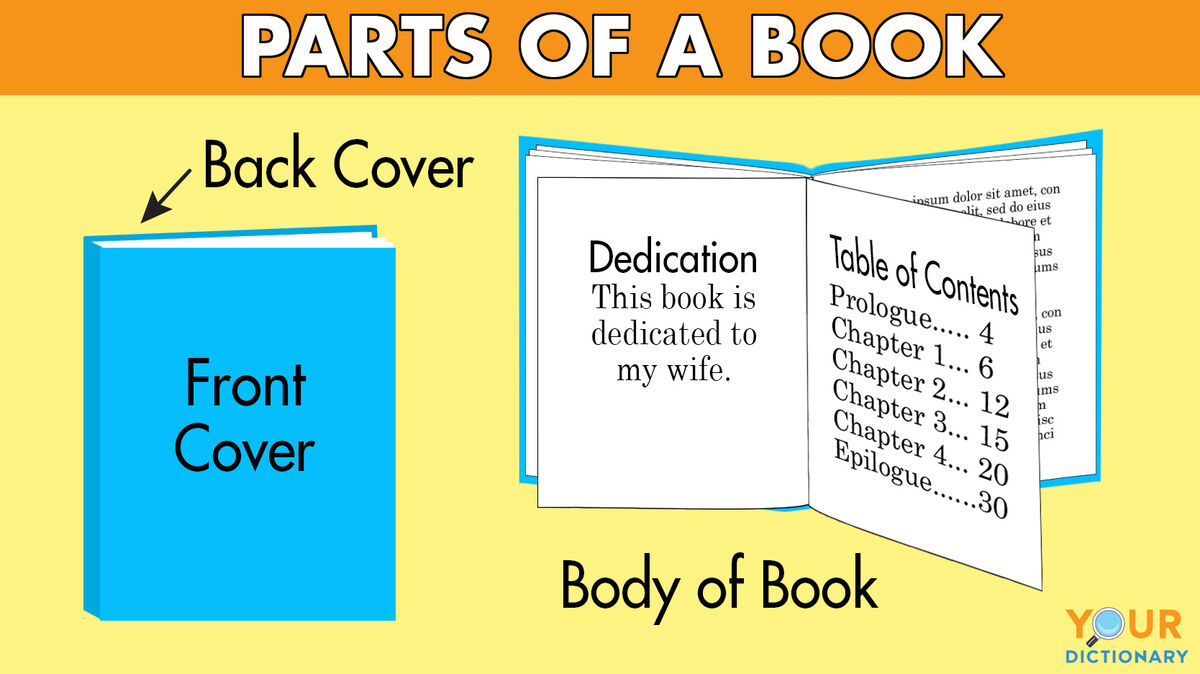
Whether you’re thinking about writing a book or simply want to know more about how books are assembled, learning the parts of a book is a great way to get started. From the front cover to the back, discover the names of the physical parts of a book.
Front Cover of a Book
The front cover of a book is extremely important, whether the work is fiction or nonfiction. Unless someone goes online or to a bookstore specifically seeking out a particular book, the cover is what will capture the attention of potential readers. It should be professionally designed with quality artwork that appeals to the target audience and accurately reflects the content. In addition to appealing graphics, the front cover also includes the author’s name and book title.
Front Matter
The sections of a book prior to the body (the actual book content) are referred to in the publishing industry as front matter.
Title Page
Books begin with a title page that lists the book’s title and the author’s name. If the book has a subtitle, that is also included on this page. The publisher’s name is sometimes included here as well.
Copyright Information
The page after the title page typically begins with copyright information. It also includes other details relevant to ownership and usage rights. This section typically includes:
- book title, copyright year and author’s name (XYZ Title. Copyright © 2020 by Mary White)
- rights statement, ordinarily worded as “all rights reserved”
- country where the book was printed
- publisher’s name, address, and website address
- designer/artist credit for cover and jacket art as well as any illustrations or photographs in the book
- book details as specified in the Library of Congress (if applicable for the book)
- International Standard Book Number (ISBN)
- information about bulk ordering
Dedication
If the author has dedicated the book to a person or group of individuals, a statement to that effect is generally included on the next page. This information typically appears alone on a page, with no other information.
Table of Contents
If the book has a table of contents, it will appear next. Not all books have a table of contents. Most nonfiction books have a table of contents, while works of fiction, such as novels, often do not include this part.
Body of a Book
The part of a book beyond the front matter is what readers are really interested in — the content of the book itself.
Prologue
Authors sometimes include information prior to the beginning of the story to provide readers with context to better prepare them to understand certain elements of the book. This feature, called a prologue, is more common with works of fiction, though it can be part of nonfiction books.
Chapters/Content
The body of the book includes the content of the book itself, which is usually presented in the form of chapters. For works of fiction, the body of the book is the actual story as it unfolds. For nonfiction works, the body includes the author’s account of events For some books, the content isn’t broken into chapters. For example, very short children’s books or brief photo books illustrating related subject matter don’t have to be divided into chapters.
Epilogue
Some books have an epilogue, which discusses events that take place after the conclusion of the final chapter. In a work of fiction, an epilogue may provide closure for loose ends in the story. For works of nonfiction, an epilogue may provide real-life information about events related to the subject of the book.
Back Matter
Most books include additional information after the body of the book. This is known as back matter.
Acknowledgments
The most common back matter element is an acknowledgements section, in which the author thanks people who have shown support to them or provided assistance to them while they were writing the book. In this part of a book, the author typically thanks his or her family, editor and others.
Index
If the book is a work of nonfiction, an index is typically included in the back matter section of the book. This section features a list of key terms or items discussed in the book, along with the page number where each can be found.
Author Bio
Biographical information about the author is often included in the back matter of the book, though sometimes it is printed on the inside back cover or the back flap of the book jacket.
Back Cover of a Book
The back cover of a book typically includes a few paragraphs designed to preview the book to readers. It often includes a bit of detail about the content written in a way that is designed to persuade readers that they want to read the book. It may also contain quotes from book reviews or advance praise as a way of further enticing readers to choose the book.
Going Beyond the Parts of a Book
While not all books have the same parts, this is a good overview of the basic sections included in most books. Some types of books have additional parts beyond the ones listed here while others have fewer. Ultimately, the author and the publishing company determine exactly which parts will be included with a particular book. Now that you’re aware of the basic parts of a book, turn your attention to perfecting the writing skills you’ll need to use to write a book. Start by learning about character voice and author’s voice in writing.